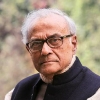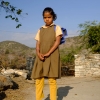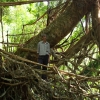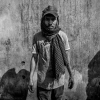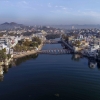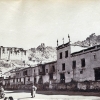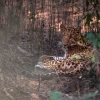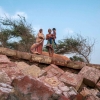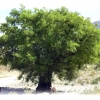How long has been your association with photography? When did you start as a photographer?
I started with a Kodak box camera in 1949. A few years later, I acquired a Voigtlander Bessa I of the 120 format. Eventually, I went on to several models of Canon 35 mm. After Kodachrome stopped production, about ten years ago, I had to go digital as no other film could give the colours and tonal effects of Kodachrome. I suppose you could say that I started taking photography seriously in the late 1950s. But I have continued to be an occasional photographer.
Has there been any photographer who influenced you or motivated you to pursue photography? If yes, can you explain in what way?
I never pursued photography as a profession. It just remained with me, I grew up with it—something I was confident about. My motivation has been entirely internal. I have tried to visualise how the camera is seeing things.
But I have been deeply impressed by Ansel Adams. When I went on an assignment to San Francisco, he was one of the first people I wanted to meet, and I called his home in Monterey. Unfortunately, he was ailing and passed away not long afterwards.
What kind of photography interests you the most?
I enjoy all kinds of photography. My photographs of architecture and dancers have appeared in well-known journals. But my primary interest is in photographing nature, particularly the Himalaya. And that includes not just the peaks, but the rivers, forests and trees. I find water and trees greatly fascinating. They offer great scope for creative work. While a fair amount of my work is in colour, I think black and white offers greater possibilities.
What has been your motivation to pursue photography?
You could say a love of nature.
When did you start travelling in the Himalaya?
I first saw the snows of the Himalaya from Cheena peak above Naini Tal in the autumn of 1958. Next summer, I visited Kalimpong and then went to Nathu La in Sikkim. But my real exposure to the Himalaya was in the autumn of 1959 when I went on a trek to the Kuari Pass, Badrinath, Valley of Flowers and Hemkund Sahib. Those days the motorable road only allowed access till points from where one had to walk quite a long distance to get anywhere. For instance, Gangotri would be a six-day walk from Uttarkashi instead of a six-hour drive. I just fell in love with the Himalaya after my first trek and it has drawn me since.
What do you think makes the Himalayan region unique from a cultural, environmental and geo-political perspective?
Well, the Himalayan region is vast, stretching from Arunachal to Ladakh. There are many cultures and sub-cultures, and even the environmental challenges vary. There is no other mountain range with either the length or the depth of the Himalaya, or with the sharp differences on either side. The Himalaya acts as a wall to block the monsoon clouds, and also ensures life-sustaining precipitation in subcontinent. There are six countries that adjoin the region: Myanmar, India, Bhutan, China, Nepal and Pakistan. Given some of the political tensions and contested borders, there are obvious challenges in the area. Unfortunately, this also prevents a coordinated strategy to meet serious environmental issues, including that of dealing with river waters.
Can you share details of which regions you visited? Which periods did you travel?
My professional duties in the foreign service made inevitable large gaps between my visits. However, returning to India in 1989 and subsequent assignments in the subcontinent, made it possible for me to visit the Himalaya more frequently. I have been able to continue my visits after retirement in 2001 and my photographs cover the Himalayan arc, starting from Arunachal in the east to Ladakh in the west and include Bhutan, Sikkim, Nepal, Tibet, Kumaon, Garhwal, and Spiti.
What kind of logistical challenges did you face? How did you overcome those challenges?
When I started, almost sixty years ago, there were no facilities. For our first trek, we had a World War II discarded canvas tent from Chandni Chowk for four of us and the porter. It consistently leaked rainwater at night. There were no sleeping bags so we carried two blankets each. We were simply happy to be there and challenges did not worry us too much. I know things have changed in these days of ‘sponsored’ visits to mountains by universities. That’s ok. However, as a reflection of today’s ethos, I was dismayed to hear of our institutes of mountaineering taking up diesel generating sets for high altitude training camps, unmindful of the pollution they might cause. That is unacceptable.
What, according to you, are some of the habits or techniques a photographer must develop to shoot in the Himalayan region?
Generally speaking, for mountain photography one requires patience. Some of the finest works of Ansel Adams were born of patience. When you know that at a certain time of the day the light on the mountain would be just right, and wait for that moment. I have personally been able to follow this advice only rarely as most of my photography has been on the move.
Then there is the difference between what you see visually and what you may be able to see mentally. The ability to ‘see’ beyond what is visible can mark the difference between a routine documentary photograph and a creative photograph. This is most true when photographing running or turbulent water, or even composing trees.
Composition is critical in nature photography. This cannot be left to the lab! And together with composition comes perspective. I realise that peaks have their importance and sometimes need to be captured as they are. But as far as possible they should be seen in context, what I call perspective—something in the foreground that sets off their value, makes them different from simply rock and ice. Composition and perspective also depend critically at times on the angle of the lens—at eye level, waist level or even lower. Or you may have to climb a rock for a higher angle! These aspects come naturally with time and practice.
I have to add here that digital photography makes fine photography difficult! When you can rapidly take five or ten shots at no cost and hope that one would be good (or improved on the computer!), application of mind and composition become secondary, and it becomes difficult to employ the discipline required to take a good photograph. The mix of shutter speed and aperture to get the desired result is critical to good photography. Though the facilities are available in digital, there is also a great temptation to let the camera do the hard work for you. Younger photographers have to be careful of this ‘comfort’ trap. Once one has acquired the discipline with careful composition and use of aperture and shutter speed for depth and effect, liberties can later be taken.
Lastly, it is important to remember that our eye focuses only on what it wants to see, the rest becomes a peripheral blur. The camera lens, on the other hand, sees everything in the frame equally. This is why composition becomes critically important where the eye and the lens are in harmony.
How do you think the Himalayan region has changed since you first visited? What consequences do such changes have on the region?
This is an important question. I will speak of Uttarakhand and adjoining areas of Himachal. Firstly, in a broad sense, when I compare the late 50s or early 60s to what I see now, obviously there is a great deal of positive development largely due to the construction of highways and greater accessibility. However, let me make a comparison. In the late 50s and early 60s, I had visited both the Sangla valley in Himachal and the areas in Garhwal across the Barasu Pass. The conditions were equally miserable. When I revisited thirty years later, Himachal was smiling and prosperous while Garhwal was where it was earlier.
I had hoped that with a separate hill state emerging, things would improve. To my infinite regret, Uttarakhand is so steeped in traditional problems that the people have not benefited as they should have. What I find most disturbing is that development is being equated with the pouring of concrete in questionable projects, even at the village level, to the detriment of the environment while even basic medical facilities are not available. There seems to be no accountability.
The other major problem, particularly in Uttarakhand, because it is Devbhoomi, is the promotion of religious tourism. The number of tourists to Garhwal is far beyond what the infrastructure can take. Yet governments at both the centre and the state seem to be pushing the envelope, having learnt no lessons from the floods of 2013. It is reported that tens of thousands of trees have been cut down in recent years. And we hear of railways to Gangotri and other places. There will be a very, very heavy price to pay in the years to come unless sanity prevails. Meanwhile, as tourism multiplies, there is little effort to control the deposit of garbage which is choking the nullahs and rivers.
In recent years I have seen many groups of bright-eyed school students from distant corners of India discovering the Himalaya. I would like to hope that they have the determination to keep their Himalaya clean for future generations.
What is required is a balance of demands. Even as the demands of tourism are addressed, the demands of the mountains for less pollution and encroachment on its rivers and forests have also to be considered.
The challenges and the possibilities in different sections of the Himalaya may not always be identical but would have similarities where mutual learning would be helpful. I am not aware if there is any such coordinated approach towards our most precious heritage.
How do you think your photographs are important in the context of the Himalayan region in today’s times?
If they create an awareness of the wonderful heritage we have and hopefully a desire to preserve this heritage without excessive human intervention, that would be the most important contribution.

